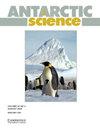Assessment of trophic segregation amongst gentoo penguin (Pygoscelis papua) individuals in Antarctica using a non-invasive methodology
IF 2
4区 地球科学
Q3 ENVIRONMENTAL SCIENCES
引用次数: 0
Abstract
Individual trophic specialization (ITS) refers to the trophic diversification amongst individuals within a population. The gentoo penguin (利用非侵入式方法评估南极洲巴布亚企鹅个体之间的营养隔离情况
个体营养特化(ITS)是指种群中个体之间的营养多样化。巴布亚企鹅(Pygoscelis papua)在种群水平上被认为是营养通才,但对其个体营养分化却知之甚少。我们评估了其主要繁殖地之一的ITS程度:南设得兰群岛的阿德利岛。我们使用了 19 只死亡个体的皮肤,通过分子方法确定了物种和性别,并使用钉子对 δ15N 和 δ13C 进行了稳定同位素分析。对种群和每种性别的同位素生态位指标和 ITS 进行了估计。我们发现,对种群和雌雄个体而言,与所消耗资源的营养位置(δ15N)相关的同位素位势指标(ITS)程度中等偏上;对种群和雌性个体而言,与觅食栖息地(δ13C)相关的同位素位势指标(ITS)程度中等偏上。雌性表现出较高的专属生态位面积,表明它们使用了雄性不使用的资源和觅食区域,这可能与繁殖能量需求有关。鉴于该物种的种群密度很高,ITS可能是减少种内竞争的一种机制。基因和同位素工具的结合使我们能够在不操纵动物或不使用入侵方法的情况下提供有关巴布亚企鹅营养生态学的相关信息。
本文章由计算机程序翻译,如有差异,请以英文原文为准。
求助全文
约1分钟内获得全文
求助全文
来源期刊

Antarctic Science
地学-地球科学综合
CiteScore
3.60
自引率
6.20%
发文量
42
审稿时长
3 months
期刊介绍:
Antarctic Science provides a truly international forum for the broad spread of studies that increasingly characterise scientific research in the Antarctic. Whilst emphasising interdisciplinary work, the journal publishes papers from environmental management to biodiversity, from volcanoes to icebergs, and from oceanography to the upper atmosphere. No other journal covers such a wide range of Antarctic scientific studies. The journal attracts papers from all countries currently undertaking Antarctic research. It publishes both review and data papers with no limits on length, two-page short notes on technical developments and recent discoveries, and book reviews. These, together with an editorial discussing broader aspects of science, provide a rich and varied mixture of items to interest researchers in all areas of science. There are no page charges, or charges for colour, to authors publishing in the Journal. One issue each year is normally devoted to a specific theme or papers from a major meeting.
 求助内容:
求助内容: 应助结果提醒方式:
应助结果提醒方式:


